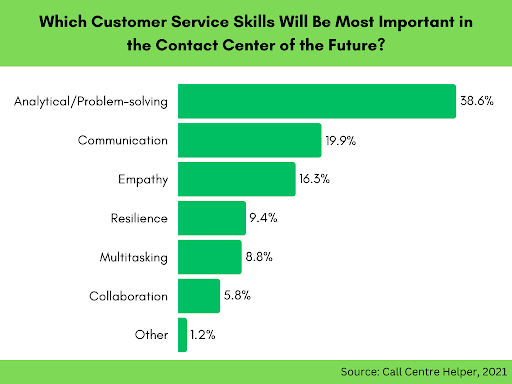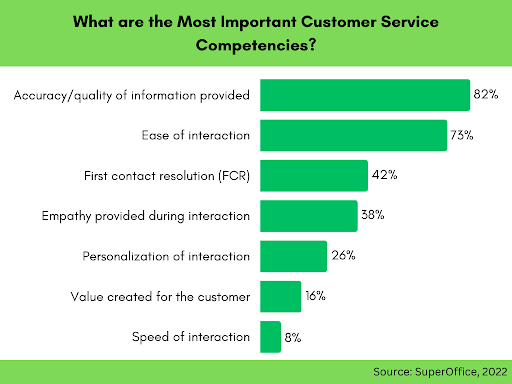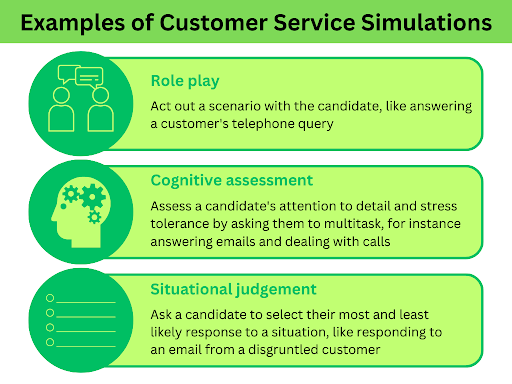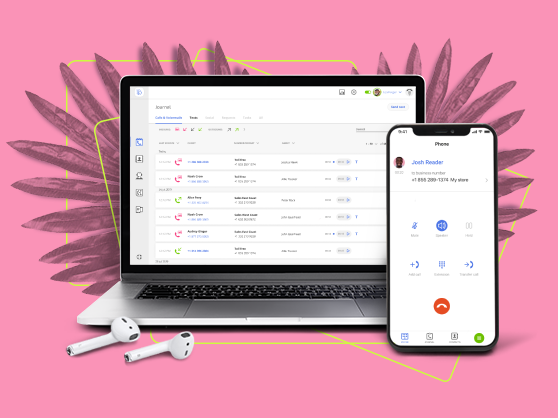Your customer service team is a vital component of your business. Excellent experiences increase consumer satisfaction, while bad service pushes customers to your competitors. This means you need a failsafe hiring process to ensure you get the most qualified and high-caliber candidates for your company.
In this post, learn how to hire customer service representatives to improve the consumer experience and foster long-term loyalty.
- When to hire customer service representatives;
- How to hire customer service?;
- Hire customer service representatives to boost satisfaction.
When to hire customer service representatives
- When your team is overwhelmed: If you’re seeing a backlog of support tickets and calls going unanswered, it indicates that your team can’t keep up with the workload.
- When you’re growing fast: Business growth is great news, but it also means an increase in product lines and orders—and a surge in customers calling with queries about them.
- When staff turnover is high: If too many of your customer support agents are quitting, it’s probably because they’re frustrated at not having enough time for each customer, or being yelled at for keeping callers waiting.
- When your metrics are heading in the wrong direction: If the figures for KPIs like average time to answer and time to resolution have snowballed, you definitely need more staff.
- When customers are unhappy: If you’re experiencing negative feedback, poor CSAT scores, and bad reviews online, it’s time to hire extra agents to turn things around.
How to hire customer service?
1. Identify your needs
First, you need to pinpoint what your existing customer service team needs. Only then can you determine your recruitment goals and identify your ideal candidates.
It’s good practice to get feedback from your customer service team about their workload and stress levels. Also, keep an eye on your forecasts and metrics.
For example, if you use attendance management software, it’s easy to track employee hours. You can see immediately if there are gaps in shifts or if customer service reps are working longer hours than they should. This software also comes with the added benefits of increased accuracy and less work for HR staff.
Once you’ve decided you need extra staff, you must determine the specifics, including the:
- Number of posts that need filling
- Skills your current team lacks
- Duties your new reps will perform
2. Clearly define the job requirements
Your next task is to write a job description. You can find templates online, but—broadly speaking—you should include the following:
- Job title and location
- An “About Us” section detailing your values, what you offer, etc.
- Duties and responsibilities
- Qualifications and experience
- Skills (required and nice- to- have)
- Compensation (salary, benefits, perks, etc.)
- Training and advancement opportunities
- A diversity and inclusion (D&I) statement
- Next steps (application deadline, how to apply, how you’ll contact them, etc.)

Duties will vary according to your company and the industry you’re operating in, but they’re likely to include customer care tasks such as answering incoming calls and handling customer complaints.
You’ll also need to consider the hard and soft skills required for the job. For a customer service rep, you’re likely to need:
| Hard skills: | Soft skills: |
|---|---|
| Good typing speed (40+ words a minute) | Analytical and problem-solving skills |
| Technical proficiency | Communication skills |
| Industry knowledge | Stress tolerance |
| Ability to multitask | |
| Empathy |
Use gender-neutral language in your listing and don’t include too many “must-haves,” as this may put some potential candidates off.
3. Determine the financial considerations
There are a few financial considerations to determine when hiring customer service reps too. These include:
- Cost of training
- Target salary
- Return on investment (ROI)
Cost of training
Even if you hire qualified candidates, you’ll need to train them on your company’s products and methods. You must thus determine how much this training will cost so you can set an accurate budget. Depending on your approach, costs may include:
- Hiring an instructor (online or in -person)
- Purchasing call center coaching tools
- Training materials, like booklets and videos
Think about what your new hires need to know to do the job effectively. The longer the training period, and the more employees you include, the more it will cost.
Target salary
According to Indeed, the average salary for a customer service representative in the US is $16.98 per hour. In the UK, it’s £7.66. That said, salaries can and do vary widely due to factors like:
- The industry. Industries like healthcare, IT, and finance usually pay more than retail.
- Location. Wages vary by country and state, and reps usually earn more in cities than in rural areas.
- Company size. Large companies can usually afford to pay more than small companies.
- Skills and qualifications. The more qualified the candidate, the more they’re likely to earn.
- Experience. Experienced reps typically earn more than reps who are new to the job.
- Type of work. Reps whot work face-to-face with customers may earn more than those who work in a call center.

Return on investment (ROI)
It’s helpful to calculate the ROI of your recruitment efforts so you know if they’re cost-effective. To do this, you can use the following formula:

You need to begin by identifying the cost of hiring and onboarding new customer service reps. Costs may include:
- Salaries of your HR staff
- Advertising and marketing costs
- Admin expenses and recruitment overheads
- Training costs
Also, identify the money you gain from your customer service team, such as upgrades, retention, and referrals. It’s worth bearing in mind that nearly 60% of customers will pay more for better customer service.
One way to get the data you need is through an ERP solution. ERP solutions unify your business data in a single place, giving you a complete picture of your costs. Plus, you can track KPIs in real-time, helping identify where your customer service reps are having an impact.
In fact, an ERP solution can help you make better decisions in every area of your business, from HR and customer service to accounting and inventory control.
4. Develop a competency framework
To narrow down your candidate pool, develop a competency framework for your customer service reps. This should define the skills, knowledge, and attributes you’d like your reps to have.
To create an effective framework, you first need to collect data from your current employees to identify the competencies needed to do their jobs. You can collect this via interviews, surveys, and observation of their day-to-day activities.
Next, break down these competencies into different categories, such as interpersonal, leadership, and functional competencies. For example:
Functional competencies
- Technically proficient
- Detailed job knowledge
- Strong analytical and problem-solving skills
- High attention to detail
Leadership competencies
- Good judgment
- Strong decision-making skills
- Credible and informative
- Stress tolerance
Interpersonal competencies
- Excellent communication skills (written and verbal)
- High degree of empathy
- Good listening skills
- Conflict resolution

Finally, review your framework to ensure you only include competencies that are essential for a customer service rep.
5. Utilize behavioral interview questions
Use behavioral questions during the interview process to assess how well candidates handle real-world scenarios. Behavioral interview questions usually start with a phrase like “Describe a time when…” or “Tell me about a situation where…”
Include a range of scenarios to assess a candidate’s experience, personality, strengths, and skills. This is a chance for candidates to reflect on their past performance.
Here are some examples of behavioral interview questions you could use:
- Describe a time when a customer raised their voice at you. How did you respond?
- Think about a time you had to give a customer bad news. What did you do?
- Tell me about a situation where you had to bring in your manager.
- Tell me what you would do if a customer wanted a refund but you weren’t sure they were eligible.
- Describe a time when you successfully resolved a customer’s issue. What was the outcome?
6. Assess candidates’ communication abilities
Effective client communication is an essential skill for customer service reps. So, you must assess their capabilities in all forms of communication 一 written, verbal, and body language. Candidates should be able to interact with customers on the phone, in person, and via email, live chat, and social media.
You could include a screening test in your job application to assess the candidates’ written communication skills. You can then have a short phone conversation with them to test their verbal communication abilities. You want candidates who are clear, calm, and friendly. They should also be good listeners.
You can record examples of calls with your business phone’s call recording feature and ask candidates to rate these interactions too. Then, ask them what they’d do differently and why.
Finally, when you interview your most promising candidates, pay attention to their body language. If they seem nervous or fidgety, they may not be a good fit for your team.

7. Consider the cultural fit of candidates
It’s also important to consider the cultural fit of job candidates. You want someone who will complement your company’s culture and values. A good cultural fit makes it more likely that potential employees will stay with your company. It also aids collaboration and team building.
In contrast, a poor cultural fit can lead to disruption and friction, which harms productivity and morale.
To ensure a good cultural fit, follow these steps:
- Define your company’s culture. List your company’s core beliefs, values, and practices. Also, think about the type of person you’re looking for (such as one with empathy who’s hardworking and a great communicator).
- Publicize your culture. Include your culture in your job description and other hiring materials, such as social media posts, to attract the right candidates.
- Look for clues in their job application. Candidates often list their skills and notable qualities here, so pay attention to these. Also, look at their cover letter. How does the person come across? What are their career goals?
- Discuss culture in the job interview. Talk about what makes your company’s culture different and ask what the candidate is looking for. If your company emphasizes teamwork but the candidate prefers autonomy, it won’t be a good fit.
You can also assess cultural fit by arranging for candidates to spend time with your customer service team.
8. Incorporate simulations during the interview process
The final step in your assessment of candidates should be to use simulations to assess how well they can perform the job. These can take a variety of forms, such as:
- Roleplay. You and the candidate act out a scene, such as a customer asking for help in a store or an angry customer on the phone.
- Written simulations. You could send anonymized real-world complaints to a candidate to see how they respond (for instance, via email).
- Virtual simulations. There are also software platforms that let you assess all aspects of the job, from answering customer tickets to updating customer accounts and logging information.

Simulations allow you to test candidates in a range of scenarios. For instance, dealing with upset customers, fielding phone calls, and using call center IVR.
If candidates do well in simulations, chances are they’ll do well with real customers too.
9. Make the final selection and offer
This step is the final part of the hiring process. Once you’ve found the most qualified people, make a shortlist of three to five applicants. Then, your selection committee can compare them and choose their preferred candidate.
Once you’ve checked your preferred candidate’s references, you can make the job offer. This may be over the phone, but it’s usually best to write a formal offer letter. This letter should include:
- Job title and description
- Candidate’s name and contact details
- Terms and conditions
- Start date, time, and location
- Dress code
- Reporting structure (including their supervisor or manager)
- Salary, benefits, bonuses, etc.
- Termination and resignation conditions
Also, include instructions on what to do next, like how to reply and the sign-by date for the contract. Remember to email unsuccessful applicants so they’re not left wondering if they got the job or not.
Hire customer service representatives to boost satisfaction
Customer service plays a vital role in your business, so you need to ensure you hire the best people. By following the steps in this post, you can select customer service representatives that fulfill your needs and boost customer satisfaction and loyalty.
Once you’ve honed your recruitment process, your next step should be to evaluate it. You can do this by tracking KPIs and requesting feedback from candidates, employees, and staff. This way, you can improve the applicant experience. You may even find ways to make the process more cost-effective一and that’s great for your bottom line.












